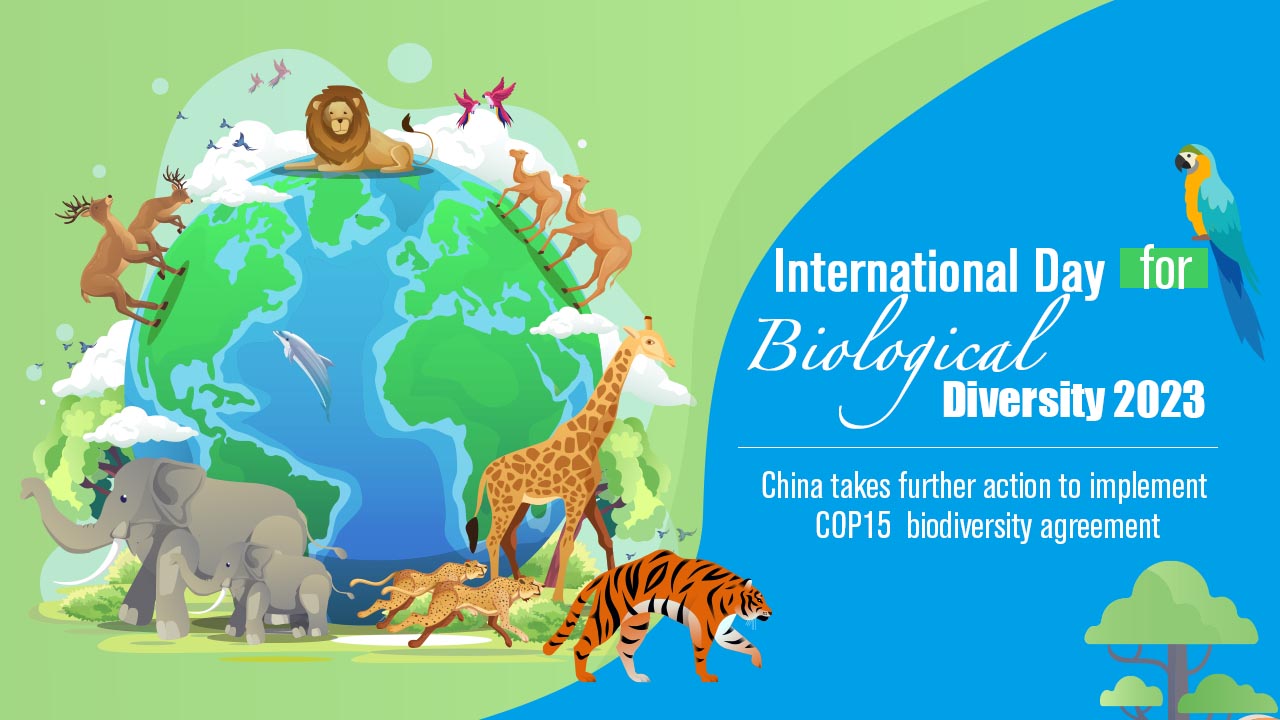May 22 is the International Day for Biological Diversity, and this year’s theme is “From agreement to action: build back biodiversity”. It promotes the idea that we must implement all the measures that the “Kunming-Montreal Global Biodiversity Framework” (GBF) sets forth before 2030.
The GBF, a historic global biodiversity agreement, was adopted at the 15th meeting of the Conference of Parties to the UN Convention on Biological Diversity (COP15) held in Montreal, Canada. With four goals and 23 action-oriented targets, it provides a framework to achieve its overarching aim to halt and reverse nature loss by 2030.

International Day for Biological Diversity 2023. /Designed by CGTN's Jia Jieqiong
International Day for Biological Diversity 2023. /Designed by CGTN's Jia Jieqiong
As the president of COP15, China has spared no effort in promoting the adoption of the framework and continuously contributed its share to the implementation of the framework.
In recent years, China has actively promoted ecological progress and biodiversity protection, promoting harmonious co-existence between man and nature.
Build ecological 'red line' system
China has completed work on a nationwide ecological protection "red line", which covers an area of more than 3.15 million square kilometers of the country's territory, with land covering more than 3 million square kilometers (more than 30 percent of China's land area) and marine area no less than 0.15 million square kilometers.
The "red line" scheme was first proposed in 2011, aiming to identify the country's crucial ecological zones under mandatory and rigorous protection. The scheme would provide supervision and special protection of these areas using 30 Chinese and foreign satellites that can spot human activities in order to prevent encroachment on these ecologically-sensitive areas.

A view of Guangzhou City, south China's Guangdong Province. /CFP
A view of Guangzhou City, south China's Guangdong Province. /CFP
Establish national park system
China established its first batch of five national parks on October 12, 2021, including the Sanjiangyuan National Park, the Giant Panda National Park, the Northeast China Tiger and Leopard National Park, the Hainan Tropical Rainforest National Park, and the Wuyishan National Park. They cover a total land area of 230,000 square kilometers, and are home to nearly 30 percent of the key terrestrial wildlife species in China.
Also, China has selected 44 other candidate areas for building national parks based on their ecological importance, unique natural landscapes and rich biodiversity, in order to better protect wildlife species and their habitats.
The national parks system streamlines the management of some China's most ecologically sensitive and valuable areas by placing entire habitats once managed by many departments across state, province and county levels under the oversight of the National Forestry and Grassland Administration and new National Park Administration.

Sanjiangyuan National Park. /CFP
Sanjiangyuan National Park. /CFP
Promote integrated protection and governance of natural environment
China has carried out holistic conservation and systematic governance of its mountains, rivers, forests, farmlands, lakes, grasslands and deserts, following the protection concept of adapting to local conditions.
A 10-year fishing ban came in to effect on January 1, 2021, in all pivotal waters of the Yangtze, China's longest river. According to China's Ministry of Agriculture and Rural Affairs, 193 species of fish were seen in key waters of the Yangtze River Basin in 2022, an increase of 25 from 168 in 2020. The 2022 Yangtze finless porpoise scientific survey showed that the population of the Yangtze finless porpoise was 1,249, an increase of 23.42 percent compared with 2017.
In 2022, China had afforested 3.8 million hectares of land and brought under control 1.8 million hectares of desertification and stony desertification. So far, China has 231 million hectares of forest, with a forest coverage rate of 24.02 percent, according to China's National Forestry and Grassland Administration.

A view of the Yangtze River. /CFP
A view of the Yangtze River. /CFP
China continues to take action to protect biodiversity. At present, China has effectively protected 90 percent of terrestrial ecosystems and 74 percent of wildlife species under national key protection.
Next, China will take further action to implement the GBF.
According to China's Ministry of Ecology and Environment, China will accelerate the improvement of policies and regulations on biodiversity protection. It will guide local governments in carrying out biodiversity surveys, monitoring and assessment, and will update China's Red List of Biodiversity.
China will continue to promote the development of the national park system. Also, it will improve the construction of ex situ conservation facilities such as botanical gardens and endangered plant propagation and ex situ conservation centers.
In addition, China will strengthen biosafety management and protection of biogenetic resources to prevent the loss of species resources and the invasion of alien species.
China will also severely crack down on illegal and criminal activities that damage the ecological environment and wildlife resources.
(If you want to contribute and have specific expertise, please contact us at nature@cgtn.com.)